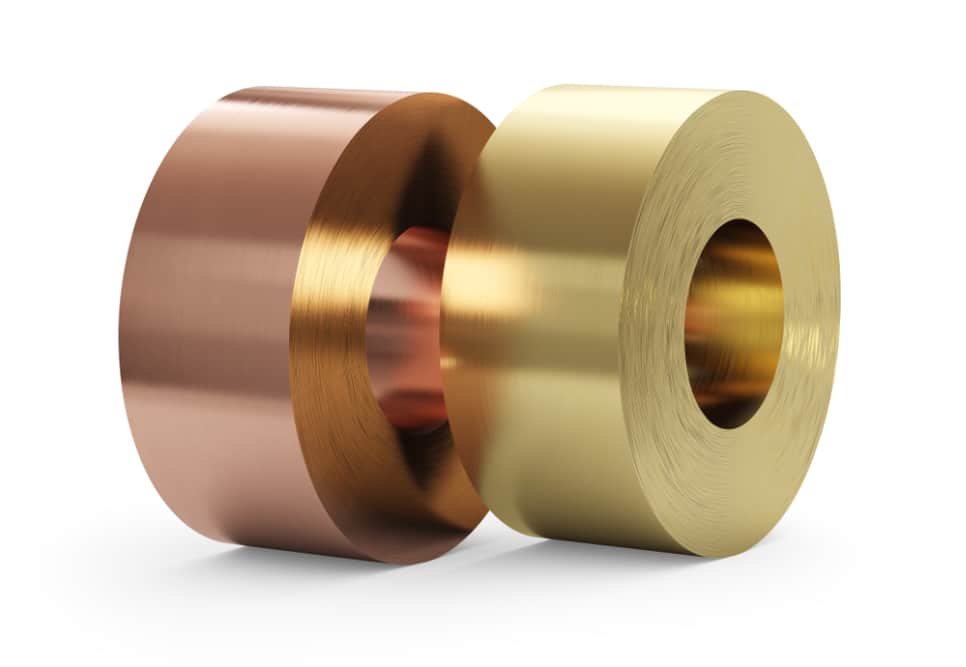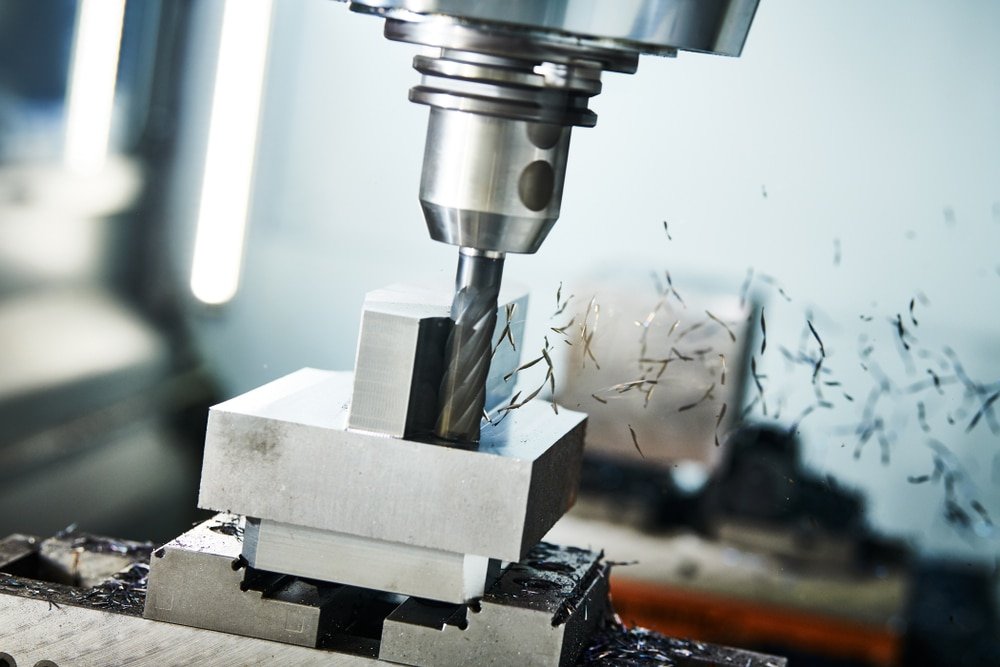When it comes to understanding metals, it’s essential to distinguish between brass, bronze, and copper, three materials that are often confused due to their similar appearances and overlapping uses. Each of these metals possesses unique properties, compositions, and applications that set them apart.
This article, MaTec Vietnam will help you explore the key differences between brass, bronze, and copper, providing insights into their distinct characteristics and how they are utilized in various industries.
Basic Overview of Copper
Copper is a naturally occurring non-ferrous metal known for its excellent properties, making it widely applicable in various manufacturing industries. Among the essential characteristics of copper are:
- Electrical conductivity
- Ductility
- Machinability
- Excellent heat conductivity
- Microbial resistance
- Corrosion resistance
Grades of Copper
Copper is a versatile metal available in numerous grades. The most typical grades consist of:
- Alloy 101: Oxygen-free, making it ideal for projects requiring excellent ductility and conductivity.
- Alloy 110 (Electrolytic Copper): Known for the highest levels of thermal and electrical conductivities, along with quality formability and ductility.
- Alloy 122: Similar to Alloy 110, but with higher weldability, malleability, machinability, and other mechanical properties.
- Alloy 145 (Tellurium Copper): Contains tellurium, which improves its electrical and thermal conductivity.
Applications of Copper
In its pure form, copper is used to make parts and products for plumbing, roofing, industrial applications, and electrical appliances. Other applications of copper in industry include:
- Architectural components
- Plumbing systems
- Heat sinks
- Submarine components
- Electric motors
- Telecommunication equipment

Basic Overview of Brass
Brass is an alloy made primarily of copper and zinc. Known for its strength and versatility, brass has several notable properties, including:
- Tarnish resistance
- Low friction
- Malleability
- Ease of machining
- Resistance to stress cracks
- Formability
Grades of Brass
Brass comes in various alloys, each suited to different applications. Some common grades include:
- Alloy 260 (Cartridge Brass): Exhibits excellent cold working features, used in ammunition parts, hardware, and more.
- Alloy 272 (Yellow Brass): Contains about 33% zinc, enhancing its weldability.
- Alloy 330: Low in lead content, highly machinable, often used in the pipeline industry.
- Alloy 353 (Clock Brass): Known for good machinability, used in wristwatches, clocks, and similar applications.
- Alloy 360 (Free-Cutting Brass): Offers superior malleability and machinability, ideal for fasteners, valves, fittings, and more.
- Alloy 385 (Architectural Brass): High structural integrity, suitable for construction and architectural applications.
- Alloy 464 (Naval Brass): Specifically designed for marine environments, resistant to corrosion and adaptable to processes like heading, soldering, and welding.
Applications of Brass
Brass, with its gold-like appearance, is used in a wide range of applications:
- Musical Instruments: Ideal for manufacturing parts of musical instruments due to its acoustic properties.
- Fittings: Perfect for making various fittings because of its unmatched properties.
- Other Uses: Plumbing materials, clock and watch fabrication, jewelry, door trim, and more.
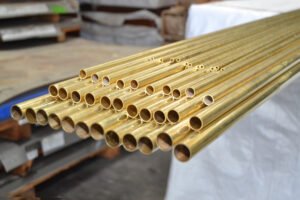
Basic Overview of Bronze
Bronze is a yellowish-brown alloy primarily composed of copper and tin, with additional elements like aluminum, manganese, silicon, and phosphorus in small amounts. It has several essential characteristics, such as:
Ductility
- Hardness and brittleness
- High melting point
- High corrosion resistance
- Low metal-to-metal friction
Grades of Bronze
Bronze comes in various grades, each with unique characteristics based on its composition:
- Alloy 932 (High-Leaded Tin Bronze): Commonly used for manufacturing washers, bushings, and similar components.
- Alloy 954 (Aluminum Bronze): Extremely strong due to the inclusion of aluminum, making it suitable for supporting and attaching industrial facilities.
Applications of Bronze
Bronze is versatile and used in a variety of applications, including:
- Bushes and Bearings: The most common use of bronze, particularly in automobile components.
- Marine Equipment: Ideal for manufacturing marine devices like propellers and ship fittings due to its excellent properties.
- Other Uses: Includes electrical springs, oil rigs, petroleum equipment, and more.
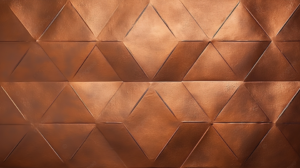
Key Disparities between Copper, Bronze, and Brass
Copper, bronze, and brass are all members of the class of metals known as red metals. While they share some properties, they also have distinct differences. Here are key differences to help differentiate them:
Element Composition
- Copper: The only natural metal among the three, copper is a non-ferrous metal that occurs naturally and can be used directly in manufacturing processes.
- Brass: An alloy of copper and zinc, sometimes containing elements like lead, manganese, iron, aluminum, and silicon.
- Bronze: Primarily composed of copper and tin, with possible additions of aluminum, nickel, phosphorus, and zinc.
Corrosion Resistance
- Bronze: Offers the strongest corrosion resistance, forming a protective layer in corrosive environments, making it ideal for marine applications.
- Copper: Has good corrosion resistance and forms protective coatings.
- Brass: While still resistant, brass has lower corrosion resistance compared to bronze and copper.
- Summary: Bronze > Copper > Brass in corrosion resistance.

Weight
- Copper: The heaviest, with a density of 8960 kg/m³.
- Bronze: Slightly lighter at 8800 kg/m³.
- Brass: The lightest at 8720 kg/m³.
- Weight Ranking: Copper > Bronze > Brass.
Durability
- Bronze: Very strong and durable, resistant to bending and corrosion.
- Copper: Durable and flexible, resistant to wear and tear.
- Brass: More prone to cracks and scratches.
- Durability Ranking: Bronze > Copper > Brass.
Machinability
- Copper: Best machinability with high flexibility.
- Brass: Less machinable than copper, not very bendable.
- Bronze: Rigid and less suitable for machining compared to copper.
- Machinability Ranking: Copper > Brass > Bronze.
Weldability
- Copper: Highly weldable, especially oxygen-free and deoxidized copper, using MIG and TIG methods.
- Brass: Weldable using MIG, TIG, and silver soldering, especially alloys with lower zinc content.
- Bronze: Also weldable, with specific methods suited to its composition.
Conductivity (Electrical and Thermal)
- Electrical Conductivity: Copper (100%) > Brass (28%) > Bronze (15%).
- Thermal Conductivity: Bronze > Copper > Brass.

Strength (Tensile and Yield Strength)
- Bronze: Highest tensile and yield strength, suitable for high-strength applications.
- Brass: Next in line with moderate strength.
- Copper: Least tensile and yield strength.
- Strength Ranking: Bronze > Brass > Copper.
Appearance
- Brass: Yellowish-golden color.
- Bronze: Reddish-brown with a dull gold tint.
- Copper: Reddish-brown with a pinkish-orange hue.
- Color Differentiation: Brass (yellowish-golden) vs. Bronze (reddish-brown) vs. Copper (pinkish-orange).
Hardness
Brinell Hardness Scale:
- Copper: 39
- Brass: 55-73
- Bronze: 40-420
- Hardness Ranking: Bronze > Brass > Copper.
Quickly Tell the Key Disparities between Copper, Bronze, and Brass
The color and sound produced by brass, bronze, and copper can help distinguish them quickly.
Color
- Copper: An appearance of reddish-brown.
- Brass: Vivid yellowish-gold appearance.
- Bronze: Dull gold shade.
Sound
- Copper: Produces a deep, low sound when gently struck.
- Bronze: Produces a higher-pitched sound than copper.
- Brass: Produces the highest-pitched sound among the three.
Copper, Brass, or Bronze: Choosing the Correct Material
Bronze, brass, and copper each have unique features that make them suitable for different applications. Consider the following factors when choosing the right metal for your project:
Degree of Flexibility
- Copper: Naturally occurring and offers the highest level of flexibility, making it ideal for applications requiring easy bending and shaping.
- Brass and Bronze: Both are durable but less flexible than copper. Bronze is more rigid, while brass offers a good balance of durability and machinability.
General Usage
- Brass: Commonly used for door knobs, musical instruments, and fittings due to its low friction and attractive appearance.
- Bronze: Best for marine applications thanks to its high resistance to saltwater corrosion.
- Copper: Ideal for food-related items like flasks and heaters because of its excellent antibacterial properties.
Prices
- Brass: The most affordable option, primarily due to its high zinc content.
- Bronze: Moderately priced, more expensive than brass but cheaper than copper.
- Copper: The most expensive of the three, reflecting its superior properties and versatility.
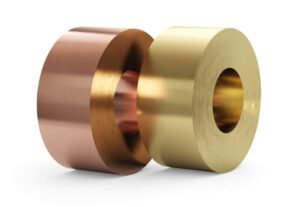
FAQ
How do the electrical and thermal conductivity properties differ among brass, bronze, and copper?
Electrical Conductivity
- Copper: Has the highest electrical conductivity among the three metals, with a conductivity rating of 100%. This makes it an excellent choice for electrical wiring and components.
- Brass: Contains copper and zinc, resulting in lower electrical conductivity compared to pure copper. Brass typically has about 28% of the electrical conductivity of copper.
- Bronze: Composed mainly of copper and tin, with additional elements, bronze has the lowest electrical conductivity among the three, at approximately 15% of copper’s conductivity.
Thermal Conductivity
- Copper: Also excels in thermal conductivity, making it ideal for applications requiring efficient heat transfer, such as heat exchangers and cookware.
- Brass: Has lower thermal conductivity than copper, but it is still relatively good, making it suitable for applications like radiators and heat sinks.
- Bronze: While not as high as copper, bronze has a higher thermal conductivity than brass, which makes it useful in situations where both durability and heat dissipation are required, such as in bushings and bearings.
What are the differences in machinability between brass, bronze, and copper?
- Copper: Copper is highly machinable and offers excellent flexibility, making it easy to work with in manufacturing processes. Its softness allows for easy cutting, shaping, and forming, but it can also lead to issues like tool wear and the need for careful handling to avoid deformation.
- Brass: Brass has a good balance of machinability and strength. It is easier to machine than both copper and bronze due to its relatively lower hardness and brittleness. The presence of zinc in brass enhances its machinability, making it suitable for precision parts like fittings and valves.
- Bronze: Bronze is more difficult to machine than brass and copper. Its higher hardness and rigidity make it less pliable, which can result in more wear on cutting tools and slower machining speeds. However, certain bronze alloys, like those with added lead, can improve machinability to some extent.
What makes copper more flexible than brass and bronze?
Composition and Structure:
- Copper: Copper is a pure element with a relatively simple atomic structure, which contributes to its high ductility and malleability. This allows copper to be easily bent, stretched, and shaped without breaking.
- Brass and Bronze: Both brass and bronze are alloys, meaning they are composed of copper combined with other elements (zinc in brass, and tin in bronze, along with other possible additions). The presence of these additional elements disrupts the regularity of the atomic structure, making the metals harder and less flexible compared to pure copper.
Crystalline Structure:
- Copper: The face-centered cubic (FCC) crystalline structure of copper allows atoms to slide past each other easily, enhancing its flexibility and ductility. This structure facilitates deformation without fracture.
- Brass and Bronze: The introduction of zinc or tin into copper to form brass or bronze alters the crystalline structure, making these alloys more rigid. The atoms in these alloys do not slide past each other as easily as in pure copper, reducing their overall flexibility.
Impurities and Alloying Elements:
- Copper: As a pure metal, copper has fewer impurities that can create barriers to dislocation motion, which is a key mechanism in metal deformation. This lack of impurities contributes to its high flexibility.
- Brass and Bronze: The alloying elements in brass and bronze create obstacles to dislocation motion, increasing the strength and hardness of the material but reducing its ability to deform easily.
>>> Read more: What Is the Difference between Titanium vs Stainless Steel?
Conclusion
Overall, MaTec Vietnam helped you understand the key disparities between copper, bronze, and brass is essential for selecting the right material for specific applications. Copper, as a pure metal, offers unparalleled electrical and thermal conductivity, along with exceptional flexibility and ease of machining.
Brass, an alloy of copper and zinc, balances good machinability with durability and is commonly used in decorative and functional applications such as fittings and musical instruments.
Bronze, primarily an alloy of copper and tin, stands out for its superior corrosion resistance and strength, making it ideal for marine and industrial uses. Each metal brings its unique set of properties, allowing for a wide range of uses depending on the requirements of durability, conductivity, corrosion resistance, and workability.

